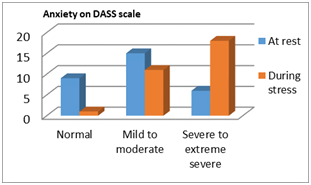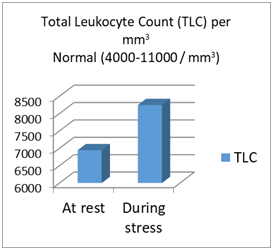MOJ
eISSN: 2471-139X


Research Article Volume 5 Issue 5
1HOD Physiology, University College of Medicine & Dentistry (UCMD), University of Lahore (UOL), Pakistan
2Assistant Professor, Physiology Department, UCMD, UOL, Pakistan
3Final Year Medical Students, UCMD, UOL, Pakistan
4Demonstrator, Physiology Department, UCMD, UOL, Pakistan
5Biostatistician, University of Health Sciences, Pakistan
Correspondence: Samina Malik, HOD Physiology, University College of Medicine & Dentistry, University of Lahore, Pakistan
Received: July 30, 2018 | Published: September 20, 2018
Citation: Ilyas A, Afzal S, Safdar MU, et al. Were you still stressed....while you were sleeping? MOJ Anat & Physiol. 2018;5(5):292-295. DOI: 10.15406/mojap.2018.05.00212
Depression, stress and anxiety constitute spectrum of the same neurological disorder which is characterized by general feeling of low mood, displeasure and low self-worth. Despite of high prevalence of these conditions, due attention is not paid to them. In order to make early recognition easy, some simple parameters should be identified so that further management can be done, if needed.
Objectives: To measure and compare perceived depression, anxiety and stress among a sample of female boarding medical undergraduates in a private school (UCMD) in association with their TLC and sleeping pulse before and after the period of exam.
Methods: The study was approved by ethical review board of University College of Medicine and Dentistry, The University of Lahore. A sample of 30 female medical students was taken after their consent and their level of depression, anxiety and stress was assessed using DASS 42, along with the measurement of their sleeping pulse and total leucocyte count, both under resting state and during time of stress.
Results: Results showed increase in level of sleeping pulse and total leucocyte count during time of stress. Similarly, stress, anxiety and depression level was found to be significantly elevated during exams, which were the major stressor of students.
Conclusion: Mind and body has linear effects over each other both during and after stressed, depressed and anxious state.
Keywords: depression, stress, anxiety, sleeping pulse, total leucocyte count
Depression, anxiety and stress, nowadays, are quite common conditions with a prevalence of 60.8%, 64.3% and 62.4% respectively as identified in a study conducted in Egypt.1 Similar trends have been observed in other parts of the world too, for example, Franciscan University in United States showed a 231% increase in annual visits related to issues of mental health. This particularly holds true for college students who are facing innumerable mental health issues these days most notably being depression, anxiety and stress.1,2 Depression refers to a common mental disorder which is characterized by low mood and energy, loss of interest, disturbed appetite and sleep and lowered self-esteem.3 While depression is a well defined mental disorder, anxiety is defined as an apprehensive uneasiness of mind as a consequence of some anticipated trouble.4 On the other hand, stress refers to the reaction of a person to some challenging situation.4,5 Stress results in different body manifestations like irritability, lack of concentration, tension and a variety of physical conditions.5 All these three conditions are characterized by considerable impact on human mind.
Particularly affected population consists of youth who face numerous stressors during their academic life like emotional issues arising as a result of living away from their families, burden of heavy syllabus and problems of education system.6 Many studies have identified the high prevalence of depression, anxiety and stress among undergraduate students with one study showing it to be 13.9% to 29.3%, 51.5% to 55%, 12.9% to 21.6% in Malaysian students respectively.7 Such adolescents with academic stress should be recognized and managed early so that the severity of condition can be controlled.8 There are multiple parameters to diagnose early depression, anxiety and stress amongst which the simplest ones include total leucocyte count and sleeping pulse.9 Depression is thought to be associated with higher levels of inflammatory cytokines and C-reactive protein. This strengthens the belief that white blood cell count is also somehow related to depression.9,10,11 Similarly, depression and anxiety disorders have important impact on psychophysiological markers like heart rate.12,13Anxiety disorders are associated with reduced heart rate variability and differences in autonomic nervous system are mainly responsible for it.12,13
Depression, anxiety and stress can be reliably diagnosed using DASS scale which consists of a questionnaire, to be filled by subjects themselves. It is a depression, anxiety and stress scale which is globally used and accepted as a tool to diagnose these conditions.14,15
Since psychiatric disorders are following an increasing trend amongst students in particular, it is of extreme importance to find easier ways that can give a clue about such conditions. So, objective of our study was to measure and compare perceived depression, anxiety and stress among a sample of female boarding medical undergraduates in a private school in association with total leucocyte count and sleeping pulse before and after the period of exams
This qualitative study was conducted on a purposive sample of 30 female boarding medical undergraduate students, between the ages of 18-20 years. Study was carried out in on-campus boarding house.
The students fulfilling the following inclusion criteria were included:
Their level of depression, anxiety and stress was assessed using DASS 42, along with the measurement of their sleeping pulse and total leucocyte count, both under resting state and during time of stress. The sleeping pulse was recorded once the students were observed to be in deep, slow wave sleep and it was confirmed by lifting the upper eyelid and checking for absence of rapid eye movements. Total leucocyte count was determined with the help of haemocytometer due to non-availability of hemo-analyzer.
The study showed that depression, anxiety and stress on DASS-42 got significantly elevated during exams. Similarly, sleeping pulse also showed a significant rise when it was measured just before the onset of exams. Total leucocyte count remained within normal range at both instances but was found significantly elevated before exam from that seen at rest (Figure 1–5) (Table 1).

Figure 1 Depression level was significantly higher during exam (chi-square McNemar test: p value 0.003).

Figure 2 Anxiety level was significantly higher during exam (chi-square McNemar test: p value 0.001).

Figure 3 Stress level was significantly higher during exam (chi-square McNemar test: p value 0.001).

Figure 4 Pulse rate increased significantly at the onset of exam than at rest (paired t test: p value <0.001).

Figure 5 Total Leucocyte count increased significantly at the onset of exam than at rest (paired t test: p value <0.001).
|
|
Mean |
Standard deviation |
|
Pair 1 |
Pulse at rest |
64.1 |
6.2 |
<0.001 |
|
Pulse in exam |
75 |
6.4 |
|
Pair 2 |
TLC at rest |
6943.5 |
2235.9 |
<0.001 |
|
TLC in exam |
8245.1 |
2574.9 |
|
Table 1 Pulse and TLC during rest and exam
Major stressors identified in our study were health related like poor quality of food in the mess as highlighted by 86% of participants. Then, psychosocial factors like living away from home was psychosocial factors like living away from home were also blamed to be a reason of stress by 40% of participants. However, 23% participants held academic issues responsible for this anxiety and stress.
This is one of the pioneer studies in our setup to explore the physiological effects of psychological conditions. In one of the studies conducted on students in India, it was concluded that depression, anxiety and stress are associated with deleterious effects on health of an individual.16 Depression, anxiety and stress in a broader look, constituted the spectrum of same core issues as identified in a study conducted on University students in Iran. This study showed that moving from adolescence to adulthood is one of the most stressful period of one’s life and a great cause of anxiety for individuals. As a result of this stress, students trying to fit in get depressed.17 This depression was found to be positively associated with white blood cell count, particularly affecting neutrophils, according to a study conducted in Japan.18 Similarly, heart rate variability was found to be reduced in anxiety disorders in multiple studies conducted in Brazil and Sweden.12,13
Certain studies have even linked increase in resting heart rate with an increased risk of developing psychiatric issues ranging from anxiety disorders to even schizophrenia.13 These and many other researchers blamed immune dysregulation and autonomic dysfunction resulting in vagal impairment for these variations in leucocytes count and sleeping pulse rate.9,10,12,13
Findings of our study go parallel to the studies conducted in other parts of the world. According to our study, pulse rate and total leucocyte count got significantly elevated during times of stress as supported by studies done in United States and other parts of the world.10,12,13 Similarly, level of anxiety, depression and stress also got elevated significantly whenever a stressor in the form of exam was faced by participants of our study. This elevation, as measured on DASS-42 suggested gross physiological changes as a consequence of psychological disturbance.
Our study helped not only in identifying major stressors for undergraduate students but it also highlighted the link between body and mind. According to our study, they work parallel to each other and as a consequence, every stress faced by the mind is reflected through physiological changes by the body, most notably being the heart rate and leucocyte count.
This study resulted in following conclusions:
Despite of revealing valuable results, our study had a few limitations:
We plan to carry out further research in this regard, by taking into account:
None.
The authors declare there is no conflict of interest.

©2018 Ilyas, et al. This is an open access article distributed under the terms of the, which permits unrestricted use, distribution, and build upon your work non-commercially.